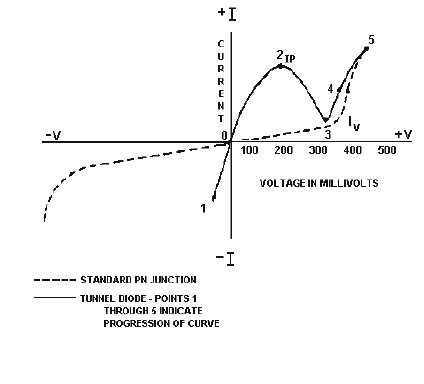3-8
Q6. Why is electron flow with the arrow in the symbol of a Zener diode instead of against the arrow as
it is in a normal diode?
The Tunnel Diode
In 1958, Leo Esaki, a Japanese scientist, discovered that if a semiconductor junction diode is heavily
doped with impurities, it will have a region of negative resistance. The normal junction diode uses
semiconductor materials that are lightly doped with one impurity atom for ten-million semiconductor
atoms. This low doping level results in a relatively wide depletion region. Conduction occurs in the
normal junction diode only if the voltage applied to it is large enough to overcome the potential barrier of
the junction.
In the TUNNEL DIODE, the semiconductor materials used in forming a junction are doped to the
extent of one-thousand impurity atoms for ten-million semiconductor atoms. This heavy doping produces
an extremely narrow depletion zone similar to that in the Zener diode. Also because of the heavy doping,
a tunnel diode exhibits an unusual current-voltage characteristic curve as compared with that of an
ordinary junction diode. The characteristic curve for a tunnel diode is illustrated in figure 3-5.
Figure 3-5.—Characteristic curve of a tunnel diode compared to that of a standard PN junction.
The three most important aspects of this characteristic curve are (1) the forward current increase to a
peak (IP) with a small applied forward bias, (2) the decreasing forward current with an increasing forward
bias to a minimum valley current (IV), and (3) the normal increasing forward current with further
increases in the bias voltage. The portion of the characteristic curve between IP and IV is the region of
negative resistance. An explanation of why a tunnel diode has a region of negative resistance is best
understood by using energy levels as in the previous explanation of the Zener effect.
Simply stated the theory known as quantum-mechanical tunneling is an electron crossing a PN-
junction without having sufficient energy to do so otherwise. Because of the heavy doping the width of

